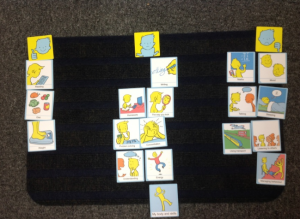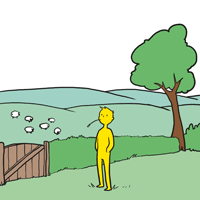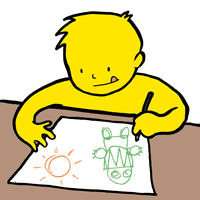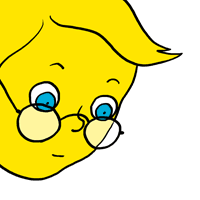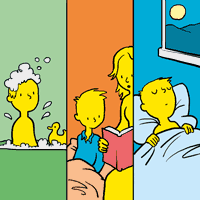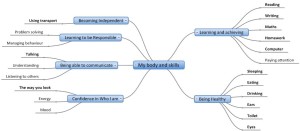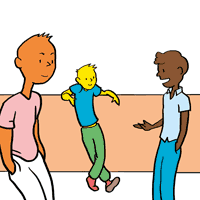 Teens are comfortable using communication tools in the form of social media. They can feel less comfortable with direct communication and often find it hard to put their feelings into words. Using a Talking Mat when talking to teenagers provides a communication tool which takes the focus off face to face interaction. It gives a thinking space to help them to express their feelings. It also allows you to have a balanced conversation because it talks about the positive things in daily life as well as the opportunity to talk about difficult things.
Teens are comfortable using communication tools in the form of social media. They can feel less comfortable with direct communication and often find it hard to put their feelings into words. Using a Talking Mat when talking to teenagers provides a communication tool which takes the focus off face to face interaction. It gives a thinking space to help them to express their feelings. It also allows you to have a balanced conversation because it talks about the positive things in daily life as well as the opportunity to talk about difficult things.
Tina is a 13 year old girl who initially had coped well with the transition to High School but in February had started to refuse to come to school. She was unable to explain what the problem was and when asked about the reason for her absence, would say “ I hate school”.
The “Consulting children and Young people -secondary resource” was used to consult with Tina. She was presented with some of the options from “My body and Skills” to think about how she was feeling. Tina used the top scale Happy(Things are going well and Not happy (things are not going well).
During the Talking Mats interview she opened up about how she felt about travelling to school (she hated going on the school bus and felt embarrassed) She clearly identified the fact that she has specific learning needs as she has difficulty understanding and concentrating in class and often falls behind with her written work. Attending her maths class was particularly difficult and she did her best to avoid going. She also talked about her difficulty with talking to adults and also to her peers. Often she feels excluded in conversations as although she is listening, she doesn’t always understand what they are discussing and doesn’t know what to say. She has a problem with sleeping and feels her mood is low a lot of the time. She also commented that she can feel extremely angry and this has a negative effect on her behaviour. On the positive side, she loves to read and feels happy about her diet and her weight.
Helping Tina to grade her feelings about specific issues helped to identify what needed to be done in the first instance to get her back to school.
Alternative travel arrangements were put in place, extra support provided for her in class and from the learning support base.
She is attending school again and the pupil support team are gathering together the appropriate “team around the child” to explore her difficulties further.
Find out more about how to use Talking Mats by signing up for a training course at Talking Mats.
The communities where children grow up can have a significant impact on the well-being of both children and families. The Consulting Children and Young people pack contains the topic “My Wider World”. This topic allows exploration of the impact of both school and life out of school as well as the support systems available to them. The World Health Organisation reminds us of the importance of gathering environmental information from children. As a child develops the environments of their everyday life are closely connected to home and school and finding out how the child feels will give insight into their independence and activity. Negative environmental factors often have a greater impact on children than on adults. In order to promote a child’s well-being, effort needs to be given to enhancing a child’s physical environment as well as their social or psychological environment.
Daniel is an 11 year old boy with a diagnosis of Asperger’s Syndrome. He completed a Talking Mat to explore the impact of his environment on his condition. He was asked to grade his responses using the top scale Happy (Things are going well) and Not happy (things are not going well).
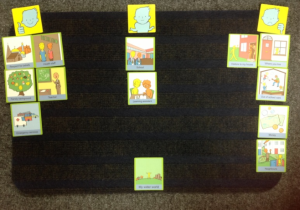
He immediately commented about how he felt about school (“yeah –it’s okay”) He expressed a strongly negative reaction when asked about where he lived. He was very unhappy about the location of his house as it is in an extremely remote location and he can never have any friends round to play. He never gets visitors to his house apart from an uncle that may drop by. He feels bad that he doesn’t have any neighbours and would love to live somewhere that has got other houses nearby. He has talked to his mum about it but she says, “she can’t take me places – too much petrol” He knows that his mum is worried about money. He also really dislikes “out of school care” as he is rarely allowed to play on the computer. He is happy with his teacher, support from health services and the emergency services.
Daniel was clearly upset about his lack of social integration and contact with his wider community.
Environmental support included supporting the care-givers in the “out of school club” by providing training and advice about Asperger’s Syndrome.
Social work became involved to help to help locate local youth groups and finance.
Find out more about how to use Talking Mats by signing up for a training course at Talking Mats.
Talking Mats is fun! Whether you are sitting on the floor completing your mat or sitting at a small table, young children enjoy the fact that they can give information through multiple channels – Talking Mats is visual, auditory and tactile. It is an engaging tool to use when consulting children.They can express a view without words if they want to or they can have a conversation if they enjoy chatting. Watching a young child thinking and reflecting about where they place their symbol on the mat can be a humbling experience. Some adults still consider young children as incapable of expressing their views or opinions but in reality they can often express strong views about things and are very capable of grading their responses. Sometimes we just don’t take the time to ask them about the issues in their lives and free up some time to listen.
Talking Mats has created a specific Early years resource to make consulting young children easier. The symbols have been graded according to their developmental stage. When using the picture symbols it is important to remember:
- Most of the symbols in the Early years pack are concrete and you can quickly identify the shared meaning for example – “drawing”
- Others are concrete but have a broader meaning. An example of this is when asking about “eyes”
We have found that it is best to allow the child to interpret the meaning at their level so it maybe they have sore eyes; they don’t like their glasses or they have brown eyes. Try not to be too prescriptive when presenting the option to the child; a symbol can act as a jump off point capturing what fits for the child at the time. Just allow the meaning to emerge.
• The abstract symbols do need a bit more explanation because they ask about more complex concepts such as safety. The Early years pack asks about safety in relation to the road, physical safety and safety around others.
Asking about daily routines will give insight into how nurtured and cared for they feel. Let the child lead the discussion as much as possible.
Using visual communication is a great way to have a conversation with children in the early years and a good tool to involve children in decision making. Listening to the child’s view is essential for the GIRFEC process in Scotland and for co-producing Education Health care plans in England and Wales. Talking Mats has created a unique resource which is based on the “International Classification of Functioning, Disability and Health – Children and Youth version” Talking Mats uses a framework which helps children to express themselves in a way they feel comfortable with. As adults we need to be able to facilitate the conversation.
We find that to realize the full potential of Talking Mats it is best to attend a Talking Mats course . The courses allow you to focus on your situation and how you can be creative and apply it in your own work,
We wanted to develop a tool that would give a holistic picture of how a child or young person feels about their lives at home at school and in their communities. We took into account the significant developmental changes that occur from 3 to 17 years and the influence of environmental and personal factors surrounding the child or young person.
We asked our artist to reflect the age and stage of the child in developing a symbol set for:
- Early years
- Primary and
- Secondary
The symbols are organised into three topics:
My Body and Skills: In this section you explore how the child is growing and developing by focussing on the functions of the body as well as skills that are emerging. You can gain an impression of how the child feels he or she is progressing physically, socially, cognitively and behaviourally.
What I do and my support: In this section you look at the child’s lived experience by asking about the activities they participate in, as well as how they feel about the support they receive.
My Wider world: The communities in which children grow up have a significant impact on the well-being of both children and families. In this section you look at the child’s wider world by exploring the impact of nursery or school as well as the support system available to them.
Talking Mats prompts you to cover the relevant topics for each age group you’re working with. You can help children and young people to see their personal strengths and abilities and take time to consider what their problem areas are.
The mind map below shows what is included in the Primary pack – What I do and my support.
If you want to read about how Talking Mats were used to help young people think about targets for their IEP read the 2012 research report.
If you would like the complete Consulting children and young people pack, covering Early years, Primary and Secondary then buy the silver resource which can be purchased either as an original or through a digital subscription.
One of the things I love about Talking Mats is that it can be used by all agencies. When thinking about the rationale behind GIRFEC the main focus is to encourage professionals to work together. It is so refreshing to have a resource that is recognised and used across the agencies.
It is not necessary to have written reports with names of assessments or measures that are a mystery to each other. Talking Mats uses visuals to capture feelings and views. The reporting of those views can be understood by children, parents and professionals.
In developing our new resource we listened and responded to a wide range of professionals. We have researched the Well-being indicators and have provided a tool to give an overview of the issues in the lives of children and young people.
Our vision is to provide a tool to listen to and capture children’s voices. We have a responsibility to be open and realistic about how we respond to what they tell us. Taking time to listen means we need to take time to respond.
We hope that Talking Mats will improve understanding throughout the whole GIRFEC team as we seek to get to the heart of what matters to the child. Margo Mackay
(more…)
Talking Mats role in child protection
Here are 3 stories of how Talking Mats has been helpful to staff from Edinburgh Council – Child Protection Team.
Use with parents
N. works with chaotic drug using parents and said “TMs was a turning point – like gold dust – it helped parents identify important issues”.
Involving child in access decisions
A young girl completed two mats the first one about going to mum’s and the second one about going to dad’s. The social worker was then able to explain to the parents how the child felt and TMs allowed the parents to discuss positive ways to unify care. The visual impact of having two differing viewpoints is very powerful.
Use of Talking Mats in children’s panels
L. has trained many Children’s Panel members in Edinburgh and some are now asking social workers if they have used a TM. Using the actual mat rather than a photo was considered to be more beneficial. “it is like the child is present in the room”. An example was given of a young child bringing in her mats about cats. She showed the panel member her mat and it acted as evidence to show the panel that the girl is now able to separate from her mother. Her mother had suffered abuse as a child and she had become over-protective of her daughter. TM increased the child’s participation.
If anyone has used Talking Mats in Child Protection we would love to hear from you.
Involving young people in making decisions that affect their education can be both challenging and time consuming. Margo Mackay has just completed a research project, funded by NHS Forth Valley, which examined whether using the International Classification of Functioning, Disability and Health – Children and Youth Version (ICF-CY) can be usefully combined with Talking Mats to provide a practical framework for decision making and target setting. It tested whether:
- combining Talking Mats and the ICF-CY framework was acceptable to secondary pupils with complex needs, and
- using the information obtained from them is helpful in setting targets for their Individual Education Plans
The project found that Talking Mats, when combined with ICF-CY, is a powerful tool with the potential to greatly enhance the nature of partnerships between pupils, parents and professionals.
 Online training login
Online training login 


